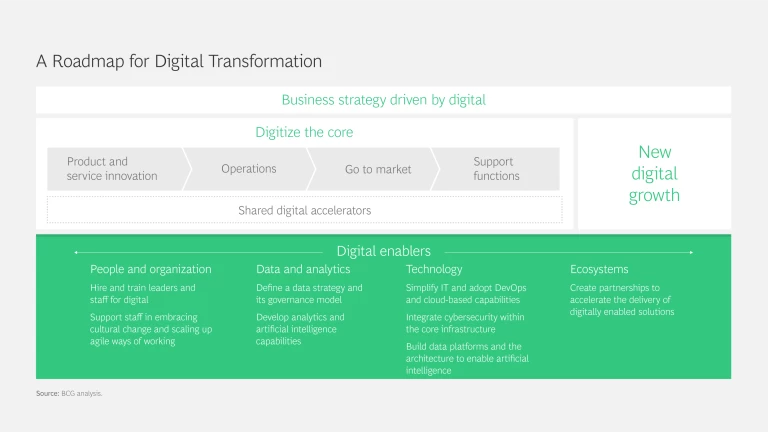The question is no longer if a company needs to pursue a digital transformation, but rather how quickly it can achieve meaningful customer and economic impact. It’s clear that the companies that are hardwired to operate in a digital world—that are able to identify new opportunities and seize them, doing both with speed and efficiency—are the ones that will lead in value creation.
The 2018 TMT Value Creators Report
This is not a prediction or a theory. As this year’s rankings show, digital natives, as well as some traditional players that are transforming themselves, are creating superior value and leading the TMT pack. However, the gap between the leaders and everyone else is likely to widen unless more companies undertake a serious and sustained transformation.
In 2017, BCG conducted a digital maturity study of more than 1,300 companies in Europe and the US. (See “ Beyond the Hype: The Real Champions of Building the Digital Future ,” BCG article, July 2017.) The study’s foundation was BCG’s Digital Acceleration Index , a metric based on companies’ self-assessment of their digital maturity. These companies’ scores fell along a wide spectrum. Although about one-quarter of the companies scored above 75 (out of 100), a similar proportion scored below 25. For those at the lower end, the gap represents real business risk. Slow starters will be less capable of innovating and responding to quickly evolving markets and customers’ needs.
This isn’t a revelation to businesses at the top or at the bottom. In a survey of companies across a wide swath of industries, BCG found that 79% of self-described “strong innovators” felt they had properly digitalized innovation processes, while only 29% of “weak innovators” said the same.
What’s less clear is how to get to the other side of the chasm. What do companies need to do to join the leaders?
The TMT leaders share one crucial trait: they have developed, and they keep building, specific skills and capabilities, or digital enablers, in-house. These enablers infuse digital efforts with increased speed, agility, and flexibility. They help companies better understand customers’ needs. And without a doubt, they are indispensable. Many companies are already making important strides in digitalizing their core and seeking new digital growth. But to unlock and sustain value creation, they also need to develop their digital enablers.
Jump-Starting a Digital Journey: The Four Categories of Enablers
Digital enablers fall into one of four broad categories, each of which is defined by core ideas and goals. (See the exhibit.)
People and Organization. High-performing companies do not approach digital as a series of isolated tactical initiatives. Instead, they establish a digital vision for the organization. The New York Times Company embodies the critical role that leadership plays in creating an enterprise-wide digital vision and embarking all employees on the journey. Crucially, the company empowered the paper’s newsroom to drive the organization’s digital agenda.
Building in-house teams to fulfill a digital vision likely means that companies will have to venture into new areas: for example, a publishing company may need to create a team of in-house app developers, or a telecom operator may need to build a team of data scientists and an agile approach to reimagine the business for digital.
These are bold moves—and essential ones. Digital natives have in-house engineering or technology teams. So do many high-performing traditional companies. But tellingly, the latter also have teams that are centered around new capabilities. For example, Orange has data and analytics teams, BT has cybersecurity ones, Recruit Holdings has teams for its online platforms, and Comcast has teams for customer experience. In some cases, these teams let companies not only better leverage new expertise in their business but also build new businesses around it. BT, for instance, is now one of the largest cybersecurity providers in the world, with a team of 2,500 experts. Recruit has successfully extended its publishing business with its web-based platforms to bring together digital and physical companies in various topic areas, such as tourism, dining, and recreation. (See “ Getting Physical: The Rise of Hybrid Ecosystems ,” BCG article, September 2017.) Indeed, building such teams can arguably be seen as one of the main reasons that some companies successfully complete their digital transformation while others do not.
To transform the way they work, incorporate fast-moving changes, and evolve products quickly, many companies have embraced agile methodologies. These practices originated in the software industry, and they are rooted in the culture and business models of most digital natives (Facebook, Google, Salesforce, and Spotify, for example). But agile has been increasingly embraced by other types of businesses. (See “ Five Secrets to Scaling Up Agile, ” BCG article, February 2016.) It’s little wonder why: agile helps to break silos in established companies and, ultimately, spur faster and better outcomes. Virtually any form of output—a pricing or advertising platform, a marketing plan, a customer service strategy, or even a postmerger integration—can be delivered in an agile fashion. (See “ Taking Agile Way Beyond Software ,” BCG article, July 2017.)
Virtually any form of output can be delivered in an agile fashion.
More and more traditional companies are investing in an agile capability; Deutsche Telekom, Electronic Arts, IBM, Telstra, and Verizon are just a few. Companies that have effectively implemented agile have discovered several keys to success, but two are critical. First, make an investment in change management. Second, ensure that there’s a commitment—and leadership—from the top to shift to a more experimental, fail-and-learn culture. Engaging employees to pursue new, even risky ideas is another practice that can help companies attract and retain talent—an essential requirement for any digital effort.
Data and Analytics. Many companies are developing and investing in capabilities around data, including sophisticated analytics. Although there is no textbook approach to creating value from data, there are some general traits that define a data-driven company. Such an organization understands the role that data and analytics play in its business, such as providing insight or guidance in product development or tracking performance. A data-driven company is also adept at identifying and pursuing use cases—often creating value in direct or indirect ways. In the telecom sector, for example, data and analytics are being used to help reduce churn rates—a particular concern in markets where penetration rates have peaked, limiting growth from new subscribers. T-Mobile USA has reduced its churn rate by 50% by analyzing social media information to identify high-value customers and target them with personalized retention
There is a good chance that any TMT company is sitting on a trove of data—information that, at a minimum, can help company leaders and teams alike make decisions more efficiently and effectively. But there is also a good chance that such a company can run into problems if it tries to do too much too soon. Large-scale, multiyear projects, involving enormous volumes of data, can quickly bog down. The better way is to adopt a phased approach, using pilots as proofs of concept and steadily building results, expertise, and momentum. Choose pilots wisely. Pick those that are meaningful to the business but not overly ambitious. The best pilots rely on skills and capabilities that are readily available—not ones that are still works in progress. (See Are You Set Up to Achieve Your Big Data Vision? , BCG Focus, June 2017.) Here, too, specialized teams can be invaluable, with in-house analytics experts supporting projects across the company.
Technology. Savvy digital players define their technical infrastructure and architecture in a more flexible and modular way. They use cloud-based solutions, integrate cybersecurity with their delivery platforms, and stress automation. One enabler that is rapidly gaining adoption among high-performing companies is DevOps—a software development culture and set of practices that relies heavily on automation. (See “ Leaner, Faster, and Better with DevOps ,” BCG article, March 2017.) DevOps works as a complement to agile, extending many of its core tenets, such as cross-functional teams, to the full software life cycle—not only development but also deployment, release, operation, and monitoring.
When Adobe shifted to internet-based business models, DevOps accelerated the company’s pace of deployment. Adobe can now push changes from testing to production environments in a matter of minutes. These capabilities go hand in hand with agile ways of working, enabling companies to deploy secure solutions to end users quickly and efficiently. Even companies outside the technology sector are using DevOps—especially as they become increasingly involved with software development, whether to support a product or a business model. Sony Interactive Entertainment and Sony Pictures Entertainment, two media subsidiaries of Sony, have been using DevOps for their cloud-based solutions. It has helped both scale up their respective platforms as the number of users and the volume of data have dramatically increased.
Ecosystems. As technologies evolve and market boundaries blur, companies will increasingly need partners and relationships in order to access the resources they require, such as talent, data, and marketplaces. These communities of players, or ecosystems, can accelerate a company’s digital journey, letting them innovate, go to market, and even enter all-new spaces without having to start from scratch alone.
Some companies aren’t only a member of an ecosystem, but a driving force behind it. Nvidia, for example, has emerged as an important player in the artificial intelligence ecosystem, investing in an array of AI startups through its GPU Ventures program and supporting others through its Nvidia Inception program. Verizon is buoying its entry into the Internet of Things space by launching the platform ThingSpace for application developers. By building platforms and ecosystems, companies gain access to users and data—and the more users and data they have, the more they can grow their own business. Already, some 14,000 developers are hosted on Verizon’s platform.
Transform and Win
Not all companies are born with digital in their blood, but the critical traits for success can be built and acquired. Deciding to undertake a digital transformation is now table stakes. Organizing for—and committing to—a multifaceted effort to truly transform a company’s portfolio and core value chain will be a differentiator. But the actions taken at the top are critical: CEOs need to take responsibility for getting the digital transformation right and show leadership. They must create the inspiration and momentum that enables their organization to move ahead of competitors and create outsized value.















